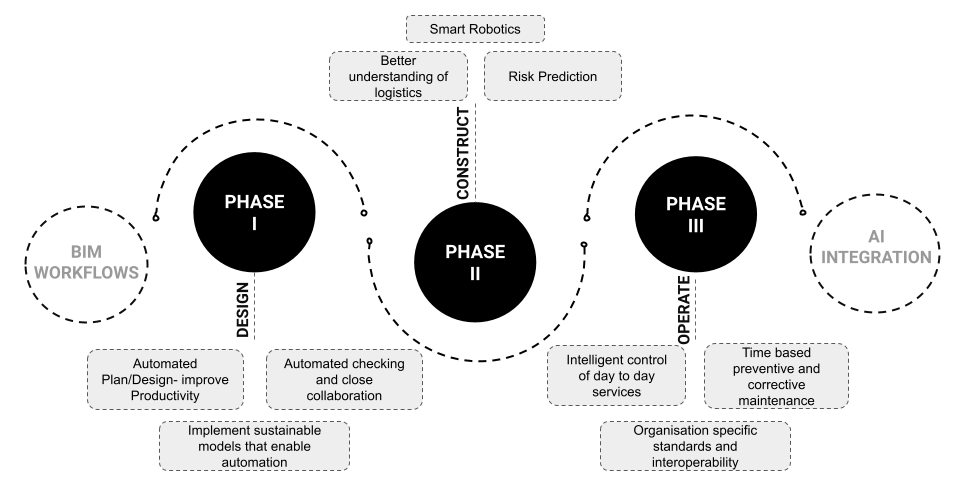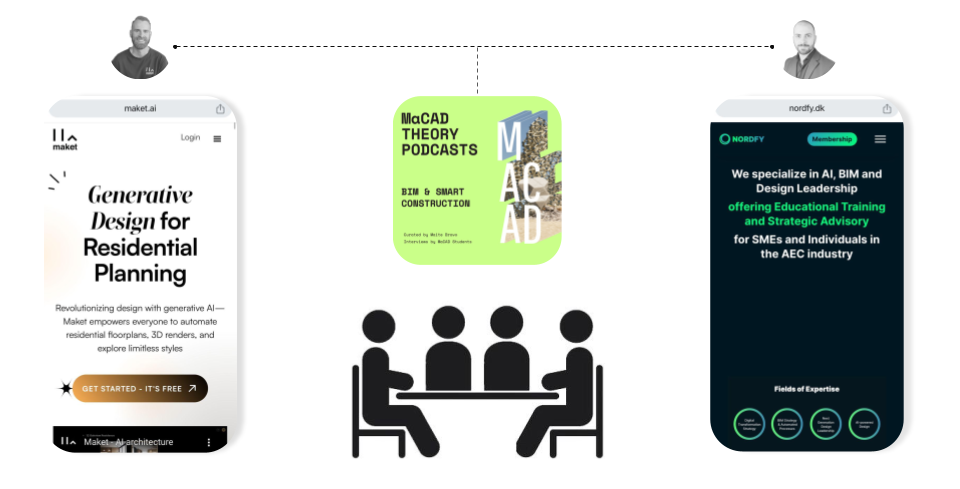
Project Statement :
The integration of AI with Building Information Modeling (BIM) aims to overcome inefficiencies, communication gaps, and limited creativity in architecture. Using tools like Grasshopper, Dynamo, and Natural Language Processing alongside BIM standards, architects can automate tasks, enhance collaboration, and drive unprecedented efficiency and innovation in the industry.
Thesis :
Integrating AI with BIM represents a transformative solution, revolutionizing workflows to foster efficiency, collaboration, and innovation. AI serves as a collaborative partner, enhancing human creativity rather than replacing it. This symbiotic relationship reshapes processes, propelling the industry forward.
Research Aim:
This study assesses AI’s impact on automating tasks, improving collaboration, fostering creativity, and ensuring security in architectural projects. It explores AI-driven tools like Natural Language Processing (NLP), Augmented Reality (AR), Virtual Reality (VR), and blockchain within BIM frameworks. Additionally, it investigates IoT integration for real-time data access. Through comprehensive analysis, the research aims to provide actionable insights for leveraging the synergy between AI and BIM for transformative advancements in the architecture industry.
Experts for the Podcast :

Patrick Murphy, CEO of MAKET AI :
Patrick Murphy, CEO of MAKET, a company leveraging generative AI to transform architectural planning and design. The journey of MAKET, established in 2019, evolved from its roots in architectural business to a forefront position in technology innovation. Initially using traditional tools like CAD, Revit, and Rhino, MAKET shifted its focus to generative AI, aiming to streamline the home building and renovation process.
Patrick shares the vision of democratizing architectural design and their ambitious goal to combine autonomous robotics and generative AI for on-demand 3D-printed homes. He emphasizes the role of generative AI in overcoming the limitations of traditional models in understanding architectural constraints and discusses the importance of applied research and collaborations, including with the Miele Institute.
Riccardo Piazzai, Co-Founder at NORDFY :
Riccardo Piazzai is an architect and BIM,AI, and Digital Twins expert, Co-founder of NORDFY, interdisciplinary Creative Agency specializing in AI, BIM, and Design. NORDFY provides educational training and advisory services for SMEs and creative individuals, at the intersection of disruptive technologies and Scandinavian design principles.
At NORDFY, Riccardo along with his partner Tiago Pereira have been privileged to assist companies on the exciting yet complex journey of integrating AI into BIM methodologies. Their experience highlights the widespread benefits of this integration, which applies to organizations of any size or budge
Area of Expertise in AI integration :
The idea for this podcast was to have both of their views as a comparison model for our podcasts based on their area of expertise when it comes to dealing with AI integration. Patrick’s focus was mainly on leveraging huge data sets to automate residential floor plans for the users. Riccardo Piazzai on the other hand looked at strategic advisory and implementation of AI-integrated BIM workflows for companies SMEs and individuals.

Topics of discussion in the Podcast :
Ideas on AI revolution and integration :
Patrick looked at this integration by developing a foundational model that reads input data sets and comprehends constraints whether structured or unstructured. Riccardo while making a point on the utilization of data sets also elaborated on how this revolutionizes the work process and improves efficiency. Using historic data sets can help in easier maintenance and operation of a building even after construction. Thus improving sustainability and efficiency.
AI Integration in Phases of Construction :
The views on this were quite subjective in the sense Patrick looked at how text-based or image-based models like the one MAKET uses can afford to get things wrong but the same can’t be true in actual building space. Riccardo who deals with this implementation for offices looks at it at the more strategic level where Ai first needs to adapt to frameworks of offices and skill size. This involves a lot of assessment, governance, design, and implementation support including data curation.
On Data Curation and Ethical Challenges :
Both the speakers spoke about the the significance of collaboration with different stakeholders and collecting high-quality data and diverse data sets.Patrick Murphy spoke on the significance of user feedback and responsible data use whereas Riccardo emphasized the importance of high-quality datasets. Emphasizing the need for a systematic approach prioritizing data diversity, Riccardo tried to highlight the role of privacy standards and strategies. Companies benefit from curated data and custom models, ensuring improved performance and privacy control and the Stakeholders play a crucial role in setting BIM requirements and AI integration standards in contracts.
Future of AI + BIM – Gloom vs Doom Scenario?
Patrick Murphy anticipates increased efficiency and envisions architects as consultants prioritizing creative vision. The conversation highlights AI’s democratization in design, proposing collaborative ventures with clients and emphasizing architects’ potential to navigate complex projects using advanced AI tools. Riccardo talks about exploring technologies like virtual reality, IoT, and augmented reality and also about the integration of digital twin technology. Envisioning a future with all design processes occurring digitally, this paradigm shift promises unprecedented opportunities for collaboration and innovation. Both speakers emphasized the need for designers to embrace AI with patience and curiosity, drawing parallels to the CAD evolution.
Podcast Conclusion – Patrick Murphy :

Podcast Conclusion – Riccardo Piazzai :

Conclusions :
If technology is the answer, the question is how the AEC industry can overcome current challenges and achieve transformative advancements. By embracing innovative solutions like AI, BIM, and automation, the industry can streamline workflows, enhance collaboration, reduce costs, and create sustainable and resilient built environments for the future

